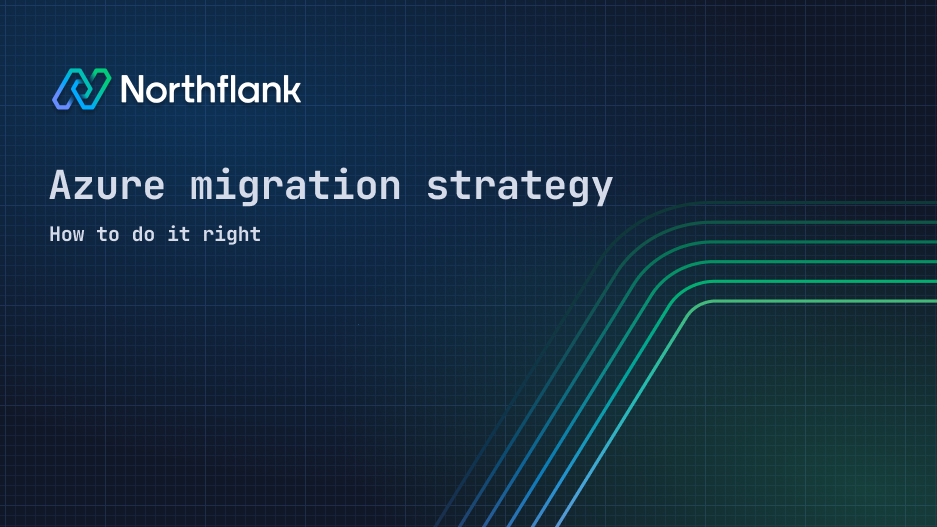

Azure migration strategy for 2025: How to get it right
When searching for "Azure migration" or exploring cloud migration options, you're likely facing one of two distinct scenarios:
(1) You want to migrate TO Azure from on-prem or another cloud
or
(2) You want to migrate FROM Azure because it's too expensive or complex
Both paths are increasingly common in 2025, and platforms like Northflank can dramatically simplify either journey. This guide covers both Azure migration strategies.
But first…
What is Azure migration?
Azure migration is the process of moving applications, data, and infrastructure either TO Microsoft Azure or FROM Azure to another platform or on-prem.
Azure migration: You're moving from your own servers or another cloud (like AWS or GCP) to Azure. Usually because you run Windows workloads, need enterprise features, or want hybrid cloud capabilities.
Migrating away from Azure: You're moving away from Azure to another cloud or back to your own servers. Usually because Azure licensing got too expensive or you're concerned about vendor lock-in.
The two Azure migration paths
Azure makes sense for enterprises. They've got deep Active Directory integration, the best Windows Server pricing (if you stay on Azure), and hybrid cloud with Azure Arc. The promise is compelling: seamless enterprise integration, pay less for Windows workloads.
Yet, to actually use Azure effectively, you need to master:
- AKS (Azure Kubernetes Service): It's managed Kubernetes, but you still need to configure node pools, set up cluster autoscaling, manage Azure AD integration, and figure out Azure CNI networking
- Resource Group chaos: Resource groups, subscriptions, management groups, Azure Policy
- RBAC complexity: Azure AD roles, custom roles, scope inheritance
- Cost mysteries: EA agreements, reserved instances, Azure Hybrid Benefit calculations, Azure billing is enterprise-grade confusing
Most teams spend months just understanding Azure's organizational structure. And that's before you deploy a single application.
This is where Northflank comes in. Instead of it being just another Azure abstraction, it's a complete Internal Developer Platform (IDP) that enterprises typically spend years building. Instead of learning Azure, you just use it.
How it works:
- Connect your Azure account to Northflank (5 minutes)
- Northflank provisions everything: AKS clusters, load balancers, networking, security 2a. Or import your existing AKS clusters. Northflank works with what you already have
- You deploy your code
What you get:
- Production-ready AKS without touching kubectl
- Automatic SSL certificates and load balancing
- Built-in CI/CD from your Git repos
- Database provisioning with one click (Azure SQL, but simplified)
- Cost controls that actually work
- Full Azure ecosystem integration (Azure SQL, Blob Storage, container registries, CDNs)
- Enterprise-grade platform capabilities teams typically spend years building
- Complete control over data residency and deployment regions
Azure can be expensive at scale, especially with their licensing model:
- Windows Server costs 4x more on AWS/GCP than Azure (Microsoft's way of keeping you)
- You're paying for reserved instances you might not use
- Complex EA agreements lock you in for years
- Every feature requires a different SKU
Moving off Azure is scary because:
- Your team only knows Azure tools and services
- You've built around Azure-specific services like Azure Functions or Cosmos DB
- Microsoft makes it expensive to run Windows elsewhere
- Going on-prem means losing that hybrid cloud magic
This is where most companies get stuck. They know Azure is getting expensive but the licensing penalties for leaving are brutal.
Northflank solves this by being cloud-agnostic from day one. Here's how migration works:
To another cloud (AWS/GCP):
- Spin up Northflank on AWS/GCP (uses EKS/GKE under the hood)
- Deploy your apps using the exact same Northflank workflows
- Plan around Windows licensing costs (or switch to Linux)
- Migrate data during maintenance window
- Turn off Azure
To on-premises:
- Get bare metal servers (or VMs)
- Install k3s or Rancher
- Connect to Northflank
- Deploy your apps (same process as Azure)
- Cancel Azure (watch those EA penalties)
Northflank is not yet another PaaS. It's specifically designed for teams that need cloud flexibility:
- Multi-cloud native: Run on Azure, AWS, GCP, Oracle Cloud, Civo, or bare metal
- No vendor lock-in: Built on Kubernetes and Docker standards
- BYOC (Bring Your Own Cloud): Your infrastructure, your data, Northflank's simplicity
- Enterprise-ready: Build your Internal Developer Platform (IDP) or Application Delivery Platform (ADP) without years of engineering
- Real company scale: Teams run 10,000+ containers in production
- Azure depth: Supports all Azure instance types across all regions
- Automatic AKS cluster setup and management
- Built-in Azure service integrations (Azure SQL, Blob Storage, etc.)
- Azure cost optimization with reserved instance awareness
- No Azure expertise required
- Cloud-agnostic deployments
- Zero code changes when switching clouds
- Windows licensing strategy consulting
- Maintain Azure-like developer experience anywhere
Under the hood, Northflank:
- Manages Kubernetes so you don't have to
- Handles ingress, TLS, load balancing automatically
- Provides GitOps workflows without the YAML complexity
- Abstracts cloud differences into a unified API
You write Dockerfiles, push code, and deploy. Whether that runs on AKS, EKS, or your own metal is just a config option.
Getting started
- Sign up for Northflank
- Connect your Azure account
- Have existing AKS clusters? Import them directly, no need to start from scratch
- Deploy a test app
- Migrate your easiest service first
- Move the rest over weeks, not months
- Pick your target (AWS? GCP? On-prem?)
- Calculate Windows licensing impact
- Set up Northflank on the new infrastructure
- Deploy a non-critical service as a test
- Plan your data migration strategy
- Move services gradually with zero downtime
Conclusion
Azure migration doesn't have to be a multi-year project. Whether you're adopting Azure for its enterprise features or escaping it due to licensing costs, the key is abstracting away the complexity while keeping the power.
Northflank does exactly that. Excellent developer experience, any infrastructure. Your choice.
Ready to migrate? Get started here or talk to an engineer.